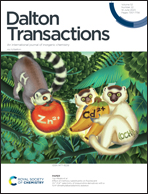Phenolato Ti(iv) hexacoordinate complexes for anticancer chemotherapy: enhancement of solubility, hydrolytic stability, and cytotoxicity†
Abstract
A new series of five titanium(IV) complexes based on diaminobis(phenolato)-bis(alkoxo) ligands with different substitutions was synthesized and characterized. All complexes were analyzed by X-ray crystallography, and all structures indicated C2 symmetrical octahedral compounds. All complexes exhibited enhanced solubility in aqueous media compared with the parent methylated derivative phenolaTi (up to 0.4 vs. 0.05 mg ml−1 of phenolaTi) due to halogen and alkoxo/hydroxo substitutions, with particularly enhanced water solubility for the methoxylated and hydroxylated derivatives. In particular, high hydrolytic stability was recorded for all derivatives, with the t½ for ligand hydrolysis of more than 8 days, as established by 1H NMR and HR-MS. All complexes were cytotoxic toward human ovarian A2780, colon HT-29, and cervical HeLa cancer cell lines (IC50 values in the range of 0.3–40 μM), with negligible activity toward non-cancerous MRC-5 cells. The halogenated compounds of this series exhibit the best combination of stability and activity, making them highly promising for anticancer applications.



 Please wait while we load your content...
Please wait while we load your content...